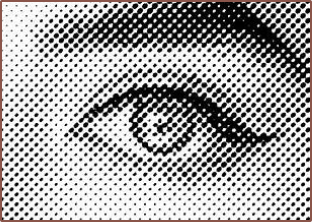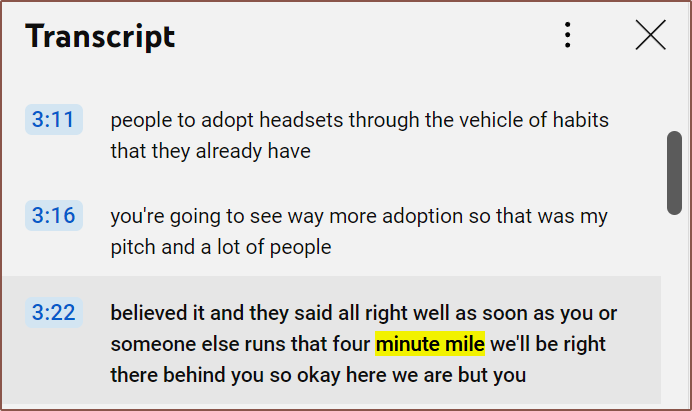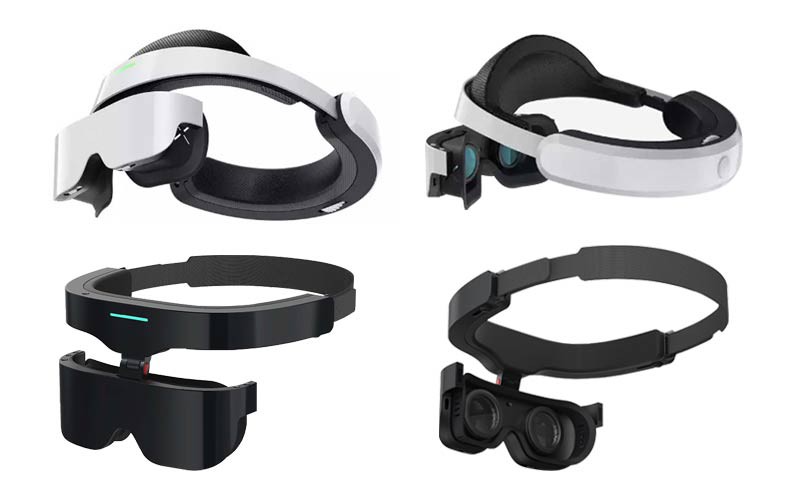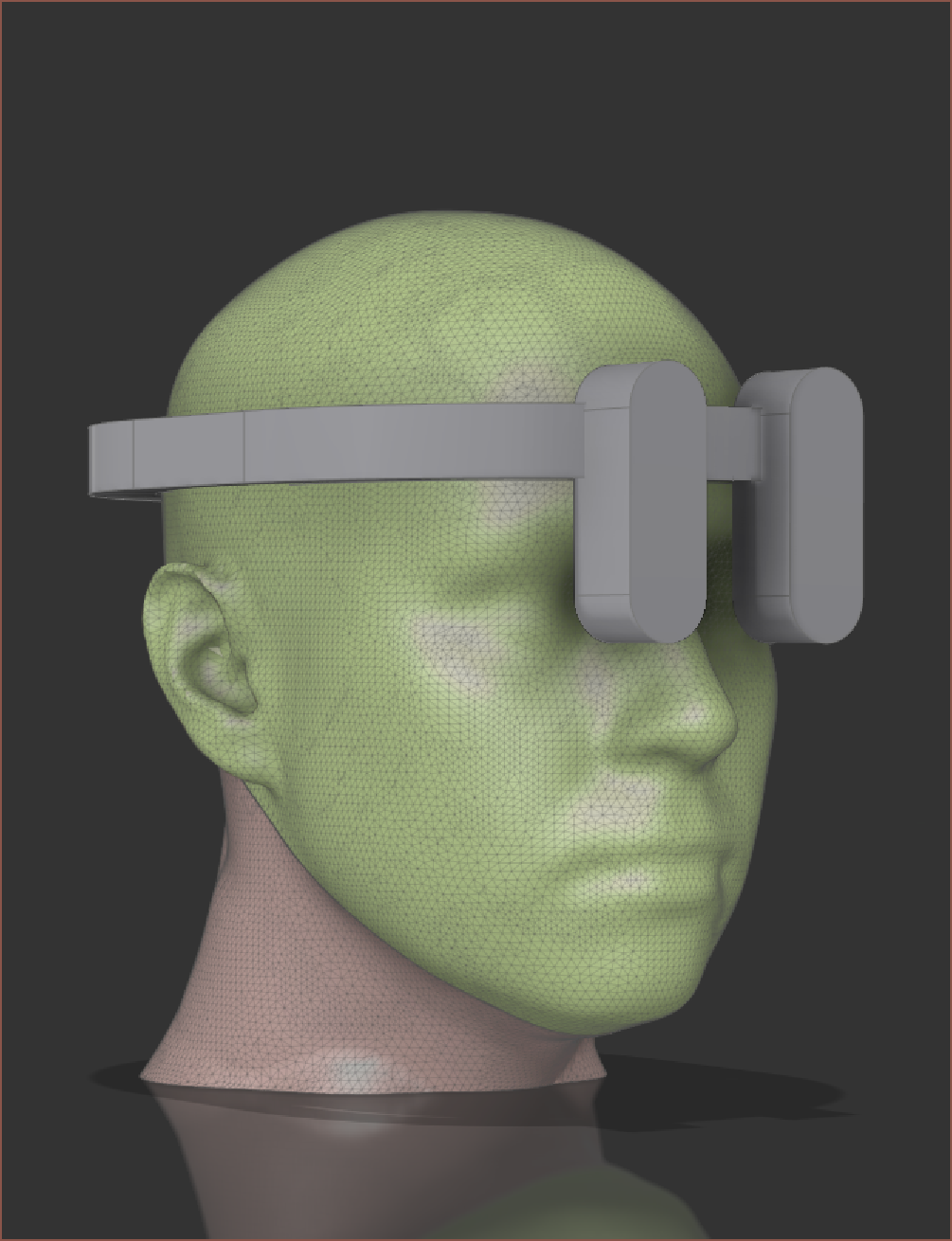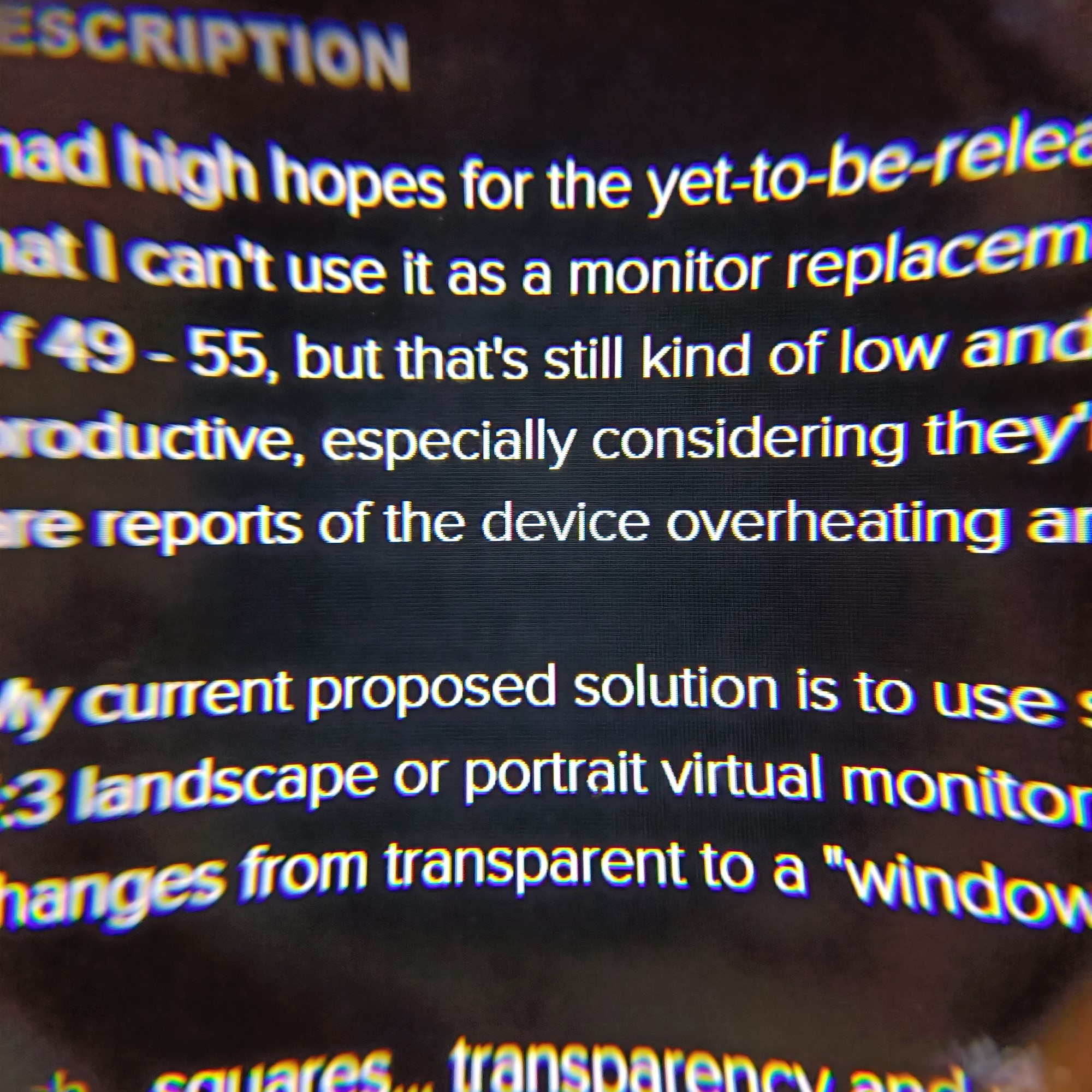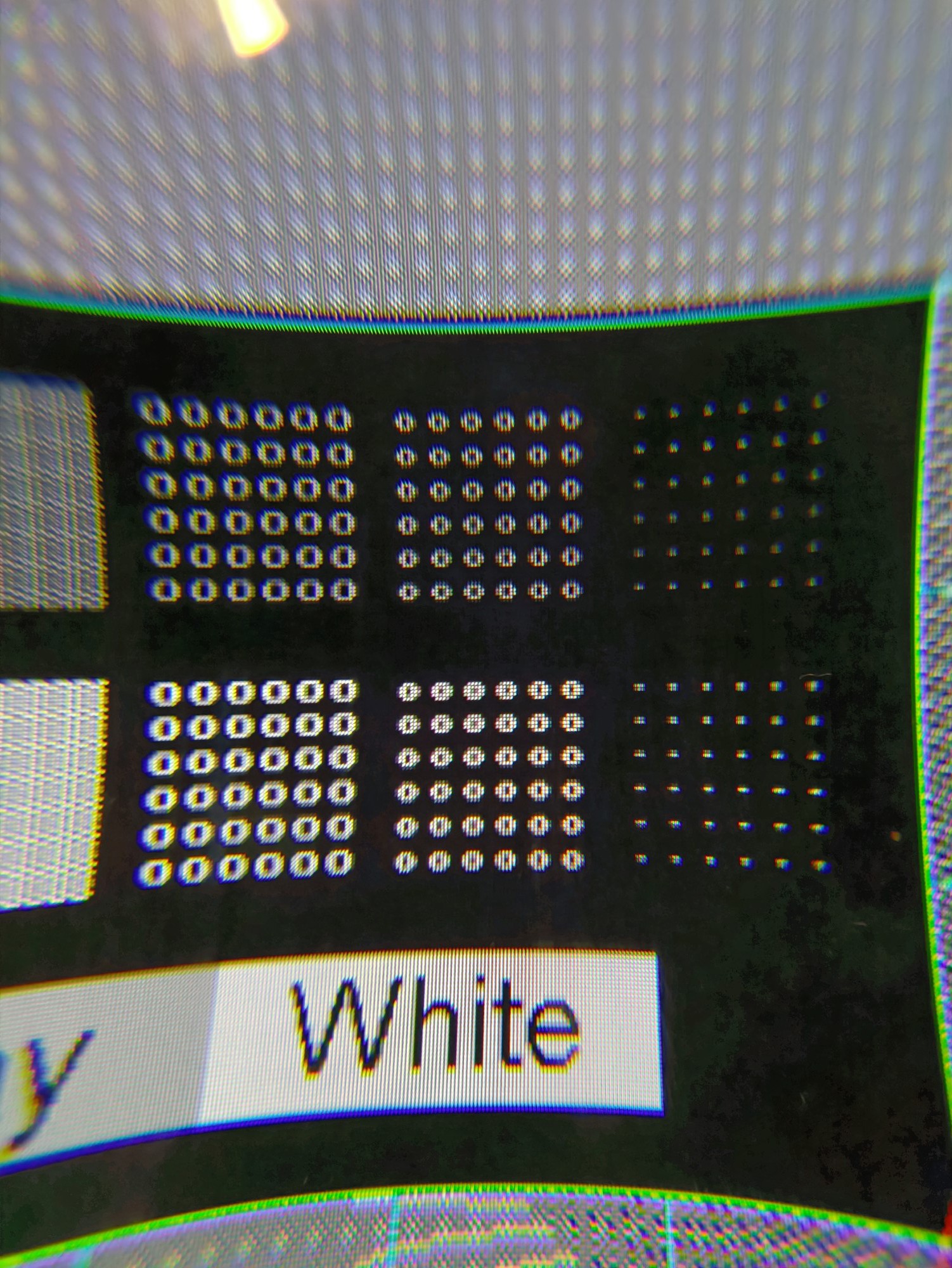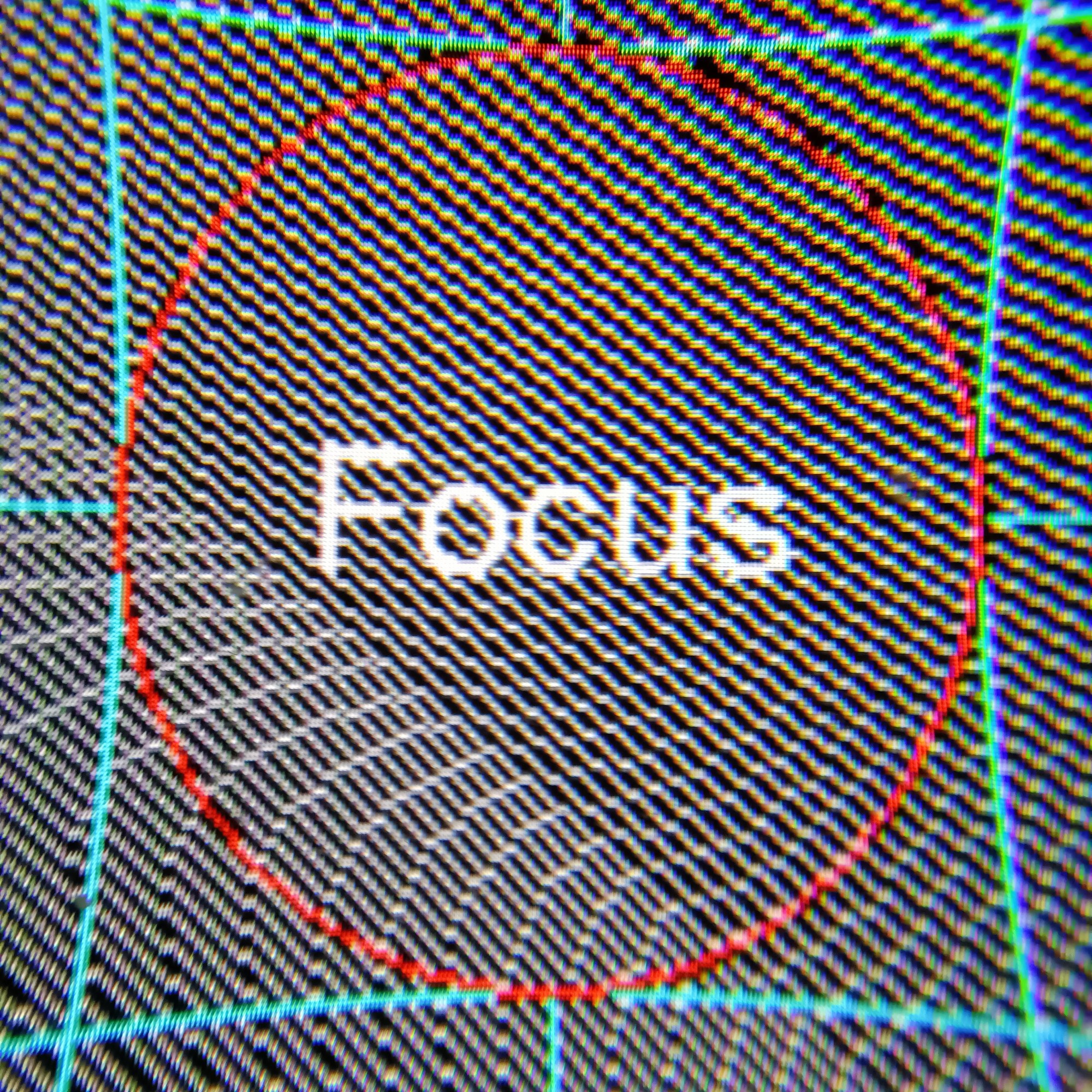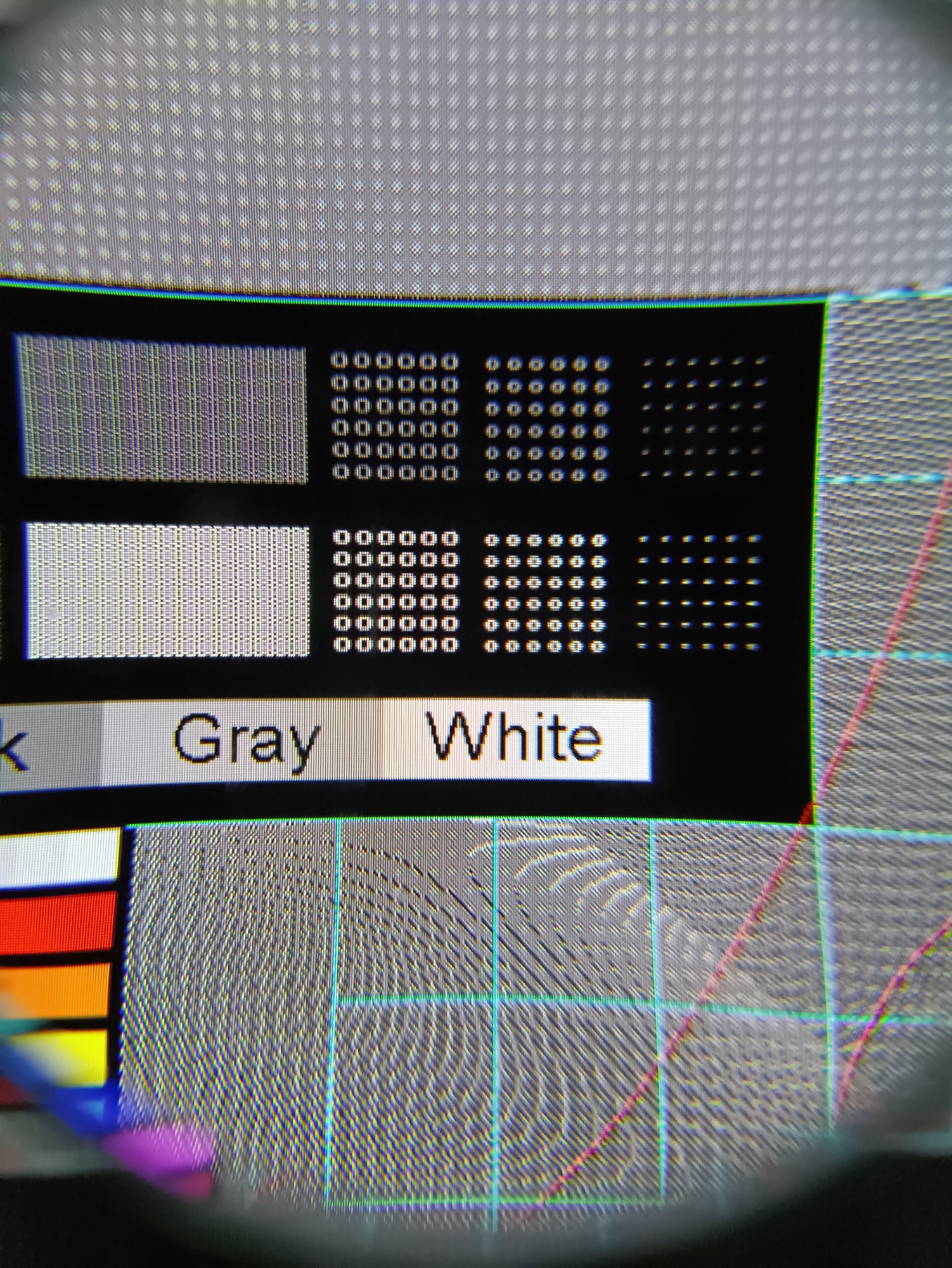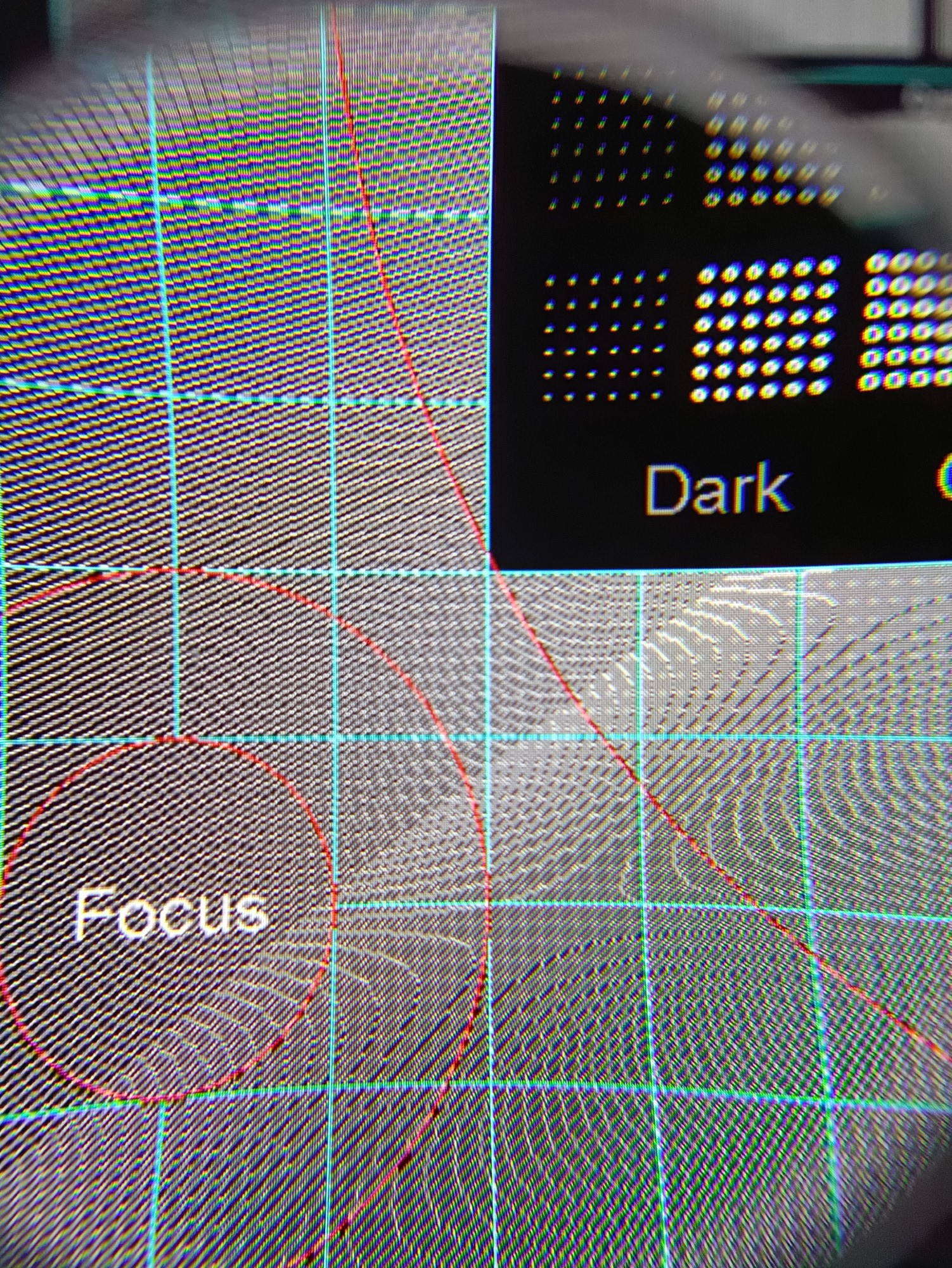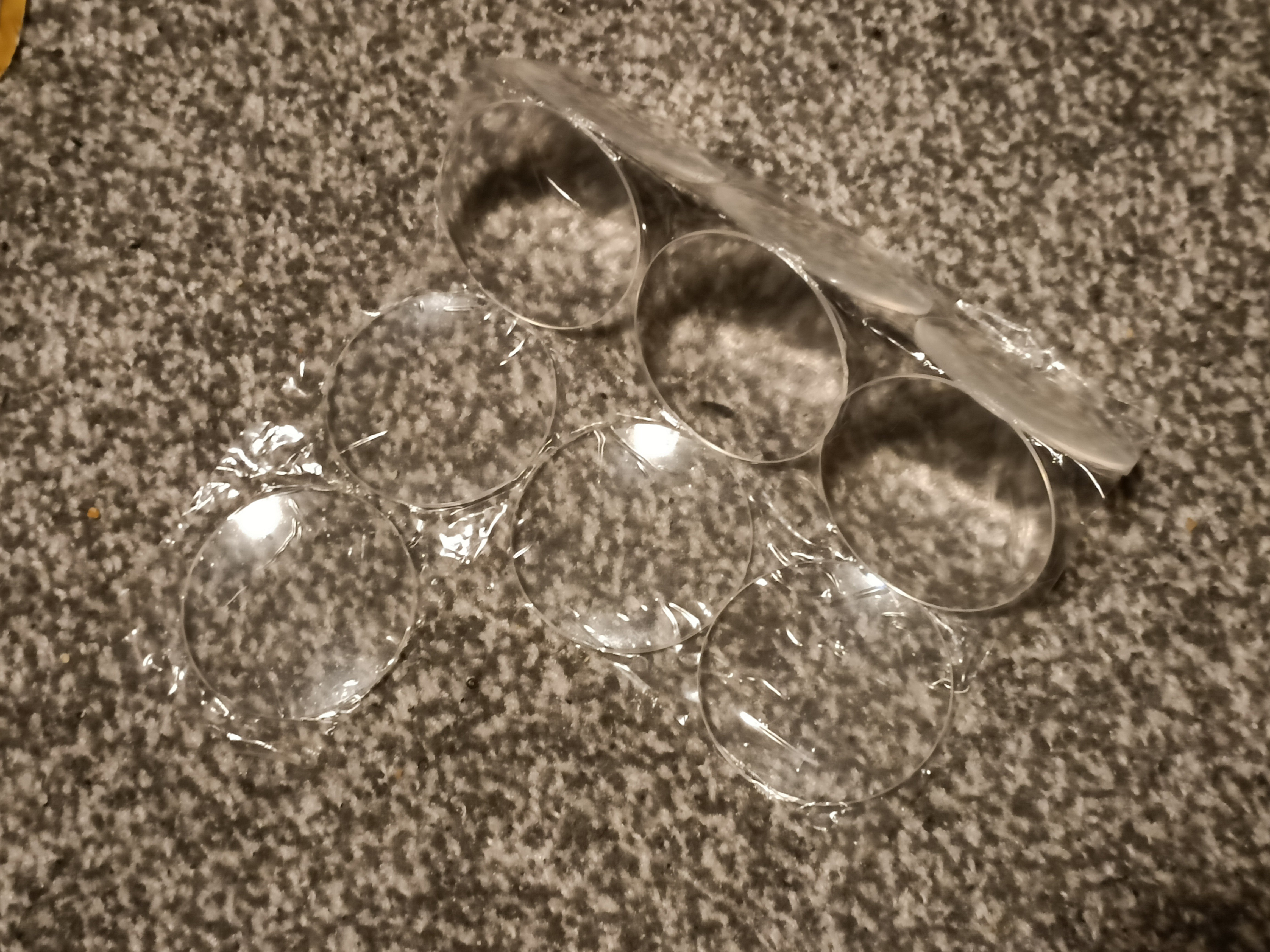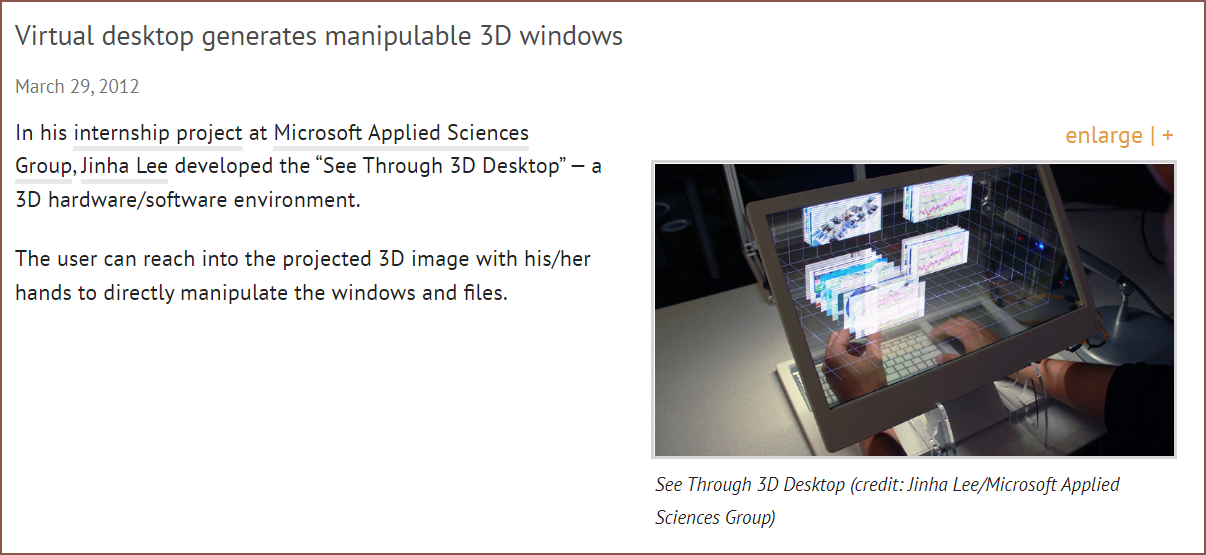-
[A] Details before Jan 13 2024
01/13/2024 at 13:58 • 0 comments[09 Feb 23]
So I've done the first optical test and the 4 x 1440px solution fails. I have concerns about brightness (and size) of using 2 x 2160p screens since I'd expect <200nits to the eye. I'm going with 2 x 2560px screens as the 2 drawbacks are its high cost (£500) and 75Hz (when over 1920x1920/eye) refresh rate, but is otherwise an ideal choice.
[09 Nov 22]
From trying different screens, I can say that:
- 70ppd looks pixelated and annoying. Must avoid.
- 80ppd is on the edge of looking pixelated. I'd like to avoid because I'm always going to be squinting, thinking "can I see pixels?".
- 90ppd is a nice balance of sharpness and Windows GUI at 100% scaling.
So it seems that 100ppd would either be ultrasharp or just indistinguishable from 90 if I extrapolated it, and that increments of 10ppd make a very noticable difference until getting to my eye's resolution, so I'd rather not imagine what Nreal Air and its 50ppd looks like.
[02 Nov 22]
I will admit that a notable reason why I'm starting this project is because of some issues with #Teti [gd0022] and its 3 screens. I've had them since Dec 2020, so I know of the challenges and limitations, which are:
- There's only 3 screens. I can store extras away when I don't need them, but if I'm really in the zone, programming something mystical like #enSweepen [gd0096], I might want 4 or 5. The only solution would be to move closer to the screen and reduce the scaling percentages of them all to fit more content.
- They weight 800 grams each. That's 2.4kg of screens to be carried inside #TetInventory [gd0039], and somehow needs to be held in place by a hinge on Teti.
- 9:16 is a very tall aspect ratio for portrait mode viewing.
- I don't like screen light coming in via my peripheral vision. It's a leading reason why I've gone with a stacked monitor setup for Teti.
- They have different white balances. I didn't expect this because they look fine by themselves, but when I turn on all 3, I can see that one is slightly bluer than another.
- They're small. 15.6" is a decent size, but I've longed for a 17.3" or larger screen.
- They're large. I know what I just said a bullet point ago, but there's still a lot of glass surface area that might be impacted or scratched one day. It's also pretty tough to hold one handed since glass doesn't have a suitable level of grip.
- They're a bit of a "black box". If they break (I've already got a stuck green pixel on one), I wouldn't really know if I could get parts to fix it or have the skill to not break something else while doing so. The firmware on them also has this annoying blue "no signal" screen that has annoyed me for the 22 months I've had the displays.
- They're 60Hz. I'm glad I went resolution over fps back in 2020, but I'd very much prefer higher Hz.
- There's no privacy. I can only imagine how curiosity inducing I'd look whilst sitting somewhere with a complete 3 monitor PC setup. Additionally, IPS panels have great viewing angles, so pretty much any 170 degree angle behind me is visible.
- Speaking about visibilty, they're glossy, meaning that anything behind me that's not dark coloured is going to reflect off the screen.
- I need something to place the screens onto, which limits the comfortable viewing positions possible.
- Tetent might not be ergonomically compatible with the dual screen laptop configuration idea.
TyMist can solve all these problems (and others, such as other things like protecting my eyes from bright light sources), and currently, it seems less complex than I originally estimated to obtain a solution.
- I can have much more than 3 screens, and I won't even be limited by the minimum angle due to the length/width of the screen. I could have 5 screens yet my neck only needs to move the angle of 2.
- I fully expect that a HMD isn't going to be 2.4kg in weight.
- 3:4 is a comfortable aspect ratio for portrait mode.
- Only the active screen and position markers for windows on other screens will be visible at a time, so the only peripheral vision light should be from the environment.
- I might still have issues with colour uniformity since the current solution uses 4 seperate panels. At least it'll be consistent between virtual monitors.
- It's large. I expect a 170" desktop at 6m away, which would be a screen 2.5m high and 3.4m wide.
- It's small, so would be easier to keep clean than 1 - 3 monitors. Additionally, any scratches would be out of focus when viewing the desktop.
- I'm making it. The screen driver boards may still be proprietary, but I know what needs to be replaced if something breaks. Additionally, if there's something like a dead pixel, I only have to spend under £40 to replace 1/4 of the virtual monitor.
- The screens I'm using are 120Hz. Ideally, I can keep the optical efficiency high enough to use the low persistence version that would greatly increase text readability while scrolling.
- This comes at the cost of contrast though, and those specific panels are not the one that comes stock in the kit I found on AliExpress.
- Maybe if you stare deep into my eyes, you'd be able to zoom in and enhance the reflection on my iris. Otherwise, the light path makes it quite difficult for onlookers to see, made slighty easier if the floor/table is glossy.
- The monitor is on my head, opening up more, ergonomic working locations.
- Tetent's was made with VR in mind.
The budget for this project isn't going to be massive, but it's higher than a pair of Nreal Air glasses. I've been planning for that Pimax 12K for a year at this point, and everything in my mind was going peacefully until the Nreal Air nation attacked. £2400 is still more than I'd like to spend on anything though, so Me In Another Timeline probably wouldn't have gone through with the purchase. It was just a nice way to think "Isn't that great? Pimax is making a solution! That's one less thing I have to invent here!".
I am a bit gutted that I didn't try and solve this solution in 2020 when I was looking for my next Laptop/PC to buy, but as you'd see below, only 5 weeks ago did I think this was going to be the most ambitious project I've ever attempted. The triple screens were already £510 when I bought them (£630 now), and then another £100+ for the Titan Ridge and all the cables. That's also after I bought and had to sell off (at a loss) 3 screens from another AliExpress seller. Then, there was all the time spent designing a case that could carry those screens. Sigh... I could've had some mini PC and battery block combo, or even just opened my laptop search results to something with 2 USBC or DP ports instead of going the Desktop PC route.
[26 Sep 2022]
Ideally, #SecSavr Suspense [gd0105] can actually be built and works as intended and used to manufacture a solution. Custom, likely high density PCBs and fancy optics sure aren't in my league budget otherwise.
Even if that happens, it'll still be my most advanced project idea I've thought of.
This project idea started yesterday, when I found out that a 1080p, 15.6" screen that is 60cm away from my eyes is 60 pixels per degree (ppd). I can't comfortably look at such a resolution for more than a few seconds before wishing for a higher resolution. I also predict that 1440p (same screen and distance) is over my eye's resolution, seeing as I can't see and additional detail when using 150% scaling on my 4K screen for #Teti [gd0022] unless I move closer.
Thus, the range is somewhere between 60 and 80 ppd. I was hoping that the upcoming Pimax 12K would be the headset that allows me to work in virtual labs and offices, but they'd have to house 24K displays for that! According to calculation, 35ppd would be the equivalent of 720P HD on a 17.3" laptop, 60cm away.
On the [Pimax 12K and under £s] market, the closest things are the newest AR glasses, like the Nreal Air, VITURE One, Dream Glass Flow and TQSKY T1, with the highest being 55ppd. (Huh. That's a lot of new AR glasses that actually look good this year.) These all use dual 1080p screens, so I'd hopefully just have to wait until a manufacturer makes a 1440p screen so that one of these startups can put them into some probably >£400 glasses. That likely will take some time, though, so I really should see what I can do now.
-
[X] Trying the Rokid Max HMD Glasses
11/19/2023 at 14:20 • 0 commentsOne day at 3am, earlier in the week, I found out that the Rokid Max was on Amazon Prime, so I got them to further learn about HMDs. Here are my impressions of them so far:
- As expected, my IPD of 73 wasn't going to work with these glasses that are designed with a fixed IPD of 65. The left half of the left eye image is a smeary blur, and the same for the right half of the right eye.
- Combined, my brain does a decent job of using the eye that obtains the highest quality image to create a full image that is mostly full resolution.
- There's something called a prizm lens that can hardware-correct this, but it'll mean that the view of the real world will also be affected.
- I found out about this and a few other tips on Rokid's "Start User" collection of Reddit posts.
- The screen really hugs the edges of the frames, meaning that it's very easy for the sides to be cut off from view. It doesn't seem to help that the eyebox is small and so my eye moving from one side to the other could cut off something that was visible in my peripheral vision.
- I belive that the sub-pixel layout isn't RGB stripe, but a more triangular / hexagonal layout. This is because text doesn't look blocky-pixelated, but more like the dithering pattern of a 2D print if you zoomed up.
- The amount of digital desktop space feels low for the amount of visible area it takes up.
- This is somewhat expected as I usually work with a 2560x1440px screen, but I felt I could fit more on my 8" N100 laptop's 1280x800px screen than the Rokid Max's 1920x1200 resolution (activated by pressing the +Volume button for a few seconds).
- The shades are, understandably, dark. This is made more apparent due to the bright image of the screen.
- The end result is that my brain filters out all but light sources/reflections (similar to filtering out the reflections from glossy monitors/screens). Optical passthough feels non existent unless most of the view is black (like a screensaver).
- The actual shades also have a bit of a distortion to them. When I look at the same point (screen off) but move my head, the image of the real world slightly moves around a bit.
- Now I better understand KGonTech's blog posts, where he calculated (for the Nreal Airs) that the real-world light transmission is about 23%.
- All the above points so far combine to make the virtual display look to be approx 35.5cm * 21.5cm, 40cm away from my eye.
- Putting those numbers into the NVidia PPD calculator, it seems I'm not far off my rough estimates since the FOV is 48 horizontal and the Rokid Max is estimated by VRCompare to be 50 degrees diagonal. Rokid claims 50 degrees but isn't clear if this is horizontal or diagonal FOV.
- Unfortunately, this results in a PPD of 40, which is half the resolution I'd want. This was expected as, ever since I found out about the NReal (now XReal) Airs, I essentially paraphrased this modified quote: "As soon as you run that 4K [display] minute mile, I'll be right there behind you". (reference to what the Immersed CEO said in an interview)
- 41.9cm diagonal = 16.5" virtual 16:10.
- These measurements were also taken when I was looking down a 7 - 8m long room to try and improve the illusion of size.
- The minimum brightness setting is red-tinted (like a low blue light filter such as Night Light on Windows) and is still quite bright in low light situations.
- There is a single button that cycles from levels 6 -> 1 and then back to 6, so I guess the tint is also a reminder to not "discord light mode meme" yourself, thinking that you can reduce the brightness further.
- l noticed in Side By Side (SBS) mode (activated by holding the brightness button (2 seconds to stretch 1920x1080 across both eyes, 4 seconds to have native 3840x1080 for both eyes) that the 3D effect looks like sets of 2D planes, like a 3D version of Paper Mario.
- Maybe this has something to do with vergence and accomodation?
- I remember that the only thing that didn't have that effect was the view of a hallway.
- While a cool experience, I had thoughts like "This should've been standard over 10 years ago" and "I'm not really losing that much information if I close one eye see this in 2D" and "There's certainly more immersion".
- The Rokid Max supports a limited colour range when running at 120Hz. I can't notice this when playing Trackmania but I do when on desktop in the form of banding.
- What I did notice in Trackmania are crispy pixels. I would've thought that it would have been less noticable than text (which is of higher contrast). Perhaps there was some ingame anti-aliasing setting I was supposed to turn on.
- My nose doesn't like the weight of these glasses and so I have a tendency to look down so that the weight isn't on them. I can barely tolerate the weight of regular glasses, so this was expected. I'd certainly be looking for a solution that doesn't put any weight on my nose at all.
- The over-ear speakers are nice, in that it's nice to be able to have headphone-like audio without something compressing my head or covering my ears. Actual sound quality is not as crisp and defined as my £30 BT headphones, but if I'm not specifically trying to listen to something (eg just playing Trackmania or having a work music playlist in the background), I wouldn't notice for a while.
- The nose bridge attachment does take quite a tug to remove them (I opted to go with the smaller nose bridge in the box instead of the preinstalled one).
- Unfortunately, GingerXR doesn't currently support the Rokid Max in wired support so I wasn't able to try out any multi monitor setup.
- As expected, my IPD of 73 wasn't going to work with these glasses that are designed with a fixed IPD of 65. The left half of the left eye image is a smeary blur, and the same for the right half of the right eye.
-
[A] Absorbing some features into Tetent
04/09/2023 at 16:17 • 0 commentsIf your're not aware, I've recently added in a 1440x1440px screen into the Tetent deliverable, to try an absorb 80% of the utility from this project.
This is a quite similar event to #SecSavr Sublime [gd0036] --> #SecSavr Suspense [gd0105] or #Tetent Turntable [gd0038] --> #Tetent [gd0090].
It seems like a handheld is more attainable than the wearable solution, #Tetent TimerSpy [gd0136], and it's possible that TyMist falls into this category too. Tetent is much more portable, I'm not expecting the BOM of the added feature to cost over £50 and the optional optical gear (magnifying glasses with led) is as low as £4 which makes the display slightly larger and easier to focus on without significant abberations.
Without the magnifying glasses, it's a 120PPD 120Hz monitor with the potential to code up multiple virtual monitors by moving or tilting Tetent.
-
[T][M] Pivot to non-optical passthough solution?
03/28/2023 at 16:56 • 0 commentsHere is an OEM VR headset, only called the "MGLASS 1" in product images:
I saw this months ago when I was asking about the 2560px screen for the first time. This headset uses them glued onto a pancake optical module, and has 2G of RAM and 16G of storage along with HDMI input.
Platform RK3566 CPU Quad-Core Cortex-A55 GPU Mali G52-2EE Memory 2GB LPDDR4
16GB eMMC5.1OS Android 11 Display Display Si-OLED Size 1.03 inch*2 Ratio 1:1 Resolution 2560*2560px per eye
(5120*2560 Binocular)Interface MIPI Luminance 1800nits Frame Rate 60HZ Max 90HZ Optics Solution pancake Optical FOV 90° Diopter 0~-8D IPD 56~72mm Dustproof IP6X Speaker Integrated Button 5 buttons Sensor and I/O Compass + Gyroscope + Accelerometer
Distance Sensor
Type C
3.5mm headphone jack
Micro SD
HDMIWireless Bluetooth 4.2
WIFI 6
Miracast
DLNA & AirplayBattery 3950mAh working temp. 5-35℃ Weight 310g Size W*H*Thickness 155*55*17.5mm Color White or Black OEM/ODM Support The reason why I've spent like 20 minutes copying in that table is a) to learn something new about copying and pasting tables, b) because this headset keeps popping up and dissapearing on AliExpress and c) clean up the formatting. The specs make this product sound like a PCVR headset + thin-client for portable situations.
Now, the reason why I've mentioned this headset is because I got an idea: non-optical passthrough near-eye display that doesn't take up any more of the users vision than required. Unlike VR headsets, where you try and block out side-light from entering, this idea tries to keep as much of the view unobstructed as possible. If anything, it's somewhat more ideal if the virtual monitor isn't see-through, from a visual perspective.
Why is the head lime green? No idea. Fusion360 just updated one day and all my custom configurations were gone and the texture of this mesh is uneditable, though it looks fine in the render. The idea is to have 2560px displays in those vertical rounded rectangles which are also motorised so that I have the option to move them out of my vision by sending a command through #Tetent [gd0090].
A potential strategy could be to get an MGLASS 1, dissassemble it and DIY a custom solution. In the world of VR, 38 degrees diagonal FOV should be very straightforward to do, though it's not like any on the market are targetting 90PPD so I might still run into issues.
Unfortunately, this expensive 2560px display seems to be an inescapable choice. Again, it's a very ideal display with its cost being the largest drawback.
-
[P] F45, 37mm "Google VR" Lens
03/16/2023 at 12:16 • 0 comments(Annoyingly, this log broke when I tried to save a draft so I have to write it all over again.)
I got this lens a while ago (March 2) and I finally got around to taking some images. I also decided to take more images of the 60mm lens but I didn't keep track of when I stopped taking pics of the 37mm lens and when I started taking pictures of the 60mm one. Also, here's the fresnel lens images to compare, and the fresnels sure look lower quality in comparison
Most of these images have been taken with 2 lenses stacked to emphasise any optical imperfections.
I think these ones are the 60mm lens
-
[T] FoV Solution Failure
03/12/2023 at 18:39 • 0 comments[18:30] So I was looking into seeing if I could obtain a valid simulation for the large 2160px displays. For 4:3 displays, I'd need 66mm of visible area.
On AliExpress, there seems to be quite a lot of options for achromatic lenses. It's kind of suspicious though because I'm not usually able to easily find so many diverse options using AliExpress search. Maybe they finally fixed / tweaked something in their systems? Well anyway there's a decent amount in the sub £10 range, but the focal distances are all quite large so it means will need to use multiple.
Well I was happily using 24 degree FoV in the simulator and I just realised that optics don't work with horizontal / vertical FoV's but the largest diagonal FoV. For the 2160px, this would be 30.5 degrees and for the 2560 this would be 36 degrees, so even if the 2560px was cheaper, I couldn't use it with a flat combiner. The quad 1440px = 2880px idea I had a few months back would've had no chance.
[19:15] A solution... fails, due to the proposed optical combiner.
-
[T] Returning to the 2160px
03/10/2023 at 17:12 • 0 comments(This log looks like a wall of text so I'm going to see if I can underline-highlight the important parts.)
Why 2160px again?
I have to remember that the main requirement is that I need enough pixels to work with. While I wouldn't be able to multitask all that well on a single FHD monitor, a 2160x2160px display can fit dual 1080p or 2:1 aspect ratio displays without even having to turn my head.
I'm still going to aim for 90PPD at 90Hz, as those two metrics are the most important for comfortable work over multiple hours/days. I'd also like to add "that doesn't cost £900" onto that list, because that's near the expected BOM cost if I were to use the 2560px screens, assuming that they cost around £650 after import taxes.
This does mean that the FOV shrinks down to 24 degrees, or 25.4 degrees at 85PPD. This is the same as an iPad Pro 12.9" that is 62cm away from the user's eyes, so it's not small in respect to other portable display devices.
Screen brightness concerns using the 2160px display can be addressed after solving chromatic aberrations. Spherical aberration seems fine(the screen would either look more like a CRT or a spherically curved monitor).
Curved or flat optical combiner?
I've been considering using the curved optical combiner, but that likely would only work for the 1" displays if I want to keep the FOV at around 30. It also seems like I'd still need lenses anyway, which is what I was trying to avoid with the curved combiner idea.
The flat, circular combiner seems like the best solution still, since it is the most likely to achieve 90PPD, which is unlikely to be true for other technologies currently known. They are made for different requirements, whether that be augmentation of visual objects, giving instructions or showing small snippets of useful information, not for use with 3D CAD and programming toolchains like with SimulaVR.
Custom PCB and MST
Like I said in the previous log, I also have the opportunity to create a custom PCB that is hopefully cheaper than the £80 (excl vat) ones on AliExpress.
I'd still have to use the MST hub I found a whilie ago, because it doesn't seem like I can access any DisplayPort 1.4 chips (or the datasheets to them so that I know how to connect and program them). The TC358860XBG is available (since 2017) and has a maximum throughput of 600 million pixels per second.
(2160^2 * 90) / (600 * 10^6) = 0.69984 = 70% utilisation
For systems that don't support MST, each eye should see the same image and should still be perfectly usable. For those that do, it would be possible to have a DP_OUT port (or USBC ideally) so that a user could connect a portable monitor to the headset to show other people their display, for work that requires accurate colour reproduction or to have one main monitor and infinite ghost / virtual monitors around it.
-
[T] SecSavr Suspense required?
03/03/2023 at 22:33 • 0 commentsFor almost all metrics, the 2560px microdisplay is better than the 2160px IPS, but the thing is that burn-in is a possibility and those SiOLEDs are expensive. Not even just a tad, but an order of magnitue more than the 2160px's. The gap reduces slightly considering I'd likely have to upgrade the backlight. Project Northstar seems to be fine with the brightness of the 1440px edition of these screens though, so it potentially could still be usable without the upgrade. I'll have to see if anyone in that project has used the headset outside though.
Additionally, I can't get full resolution @ 90Hz, but I can get 1920px upscaled @ 90Hz. 75Hz is probably fine enough, but it just adds to the difficulty of justifying the price.
The 2160px also is a low enough resolution that I could create a PCB using 2 Toshiba eDP chips to process the data. I might also look into the chip used for DP MST, but using an AliExpress hub for £30 is a bit more likely.
Anyway, it seems that off-the-shelf optics aren't going to be good enough for what I'm trying to do, and would have to spec #SecSavr Suspense [gd0105] to be able to manufacture finished optical elements, and continue this project after success. Additionally, those custom PCBs could get expensive since I'd very likely need more than 2 layers for the board. That's also something else the Suspense needs to do.
Lastly, that acrylic visor is still kind of expensive. I'm not sure if 3D printing in some future #SecSavr Syrum [gd0141] could be cheaper, but at least I'd have more geometric options for it.
Essentially, I've come back to the same conclusion I started the project with: A TyMist solution likey doesn't exist if the Suspense doesn't exist.
-
[P] Double and Half
02/17/2023 at 19:58 • 0 commentsThe lenses shipped in 11 days (bundled with other orders) and I didn't expect to get 10pcs. That's double what I thought I was ordering and I guess the listing was 2pcs x 5. I also expected the lenses to be 10-11mm but it was just over half that at 5.7mm.

Unfortunately, there's a defocused / distorted ring that is concentric with the lens centerpoint / circumference. All lenses have it and none of the product photos showed it.

Additionally, a long focal length does not seem to equate that chromatic abberation is reduced (compared to a shorter length), so white text / icons are still reddish on one side and bluish on the other.
-
[S] First look into Win32
02/14/2023 at 21:57 • 0 comments[S] = Software (for projects without the software tag)
I'm trying to think of the audio pipeline for dynamic spatial audio and soon worried about how I was actually going to show the virtual monitors from Windows 10 in the first place.
In search of the documentation, I stumbled on a 2012 showcase of a transparent monitor with hand and head tracking. It looks really advanced for something out of 2012.
 I think I've found the place I want to be at, since I need to be able to control how the desktops are animated and moved.
I think I've found the place I want to be at, since I need to be able to control how the desktops are animated and moved. Now I'm watching the below video, and have already found out something eye-opening; everything in Windows is actually made of windows, such as buttons and status bars.
Now I'm watching the below video, and have already found out something eye-opening; everything in Windows is actually made of windows, such as buttons and status bars.
 kelvinA
kelvinA